Kami are the deities, divinities, spirits, mythological, spiritual, or natural phenomena that are venerated in the Shinto religion. They can be elements of the landscape, forces of nature, beings and the qualities that these beings express, and/or the spirits of venerated dead people. Many kami are considered the ancient ancestors of entire clans. Traditionally, great leaders like the Emperor could be or became kami.

Shinto is a religion originating from Japan. Classified as an East Asian religion by scholars of religion, its practitioners often regard it as Japan's indigenous religion and as a nature religion. Scholars sometimes call its practitioners Shintoists, although adherents rarely use that term themselves. There is no central authority in control of Shinto, with much diversity of belief and practice evident among practitioners.
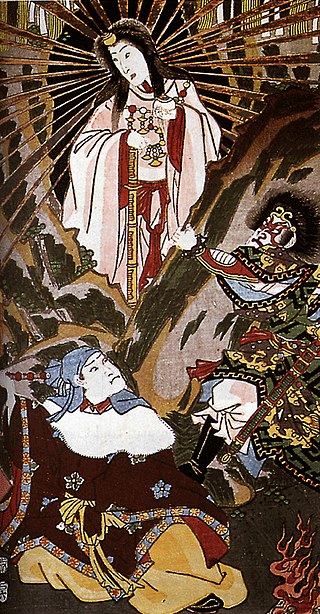
Amaterasu Ōmikami, often called Amaterasu for short, also known as Ōhirume no Muchi no Kami (大日孁貴神), is the goddess of the sun in Japanese mythology. Often considered the chief deity (kami) of the Shinto pantheon, she is also portrayed in Japan's earliest literary texts, the Kojiki and the Nihon Shoki, as the ruler of the heavenly realm Takamagahara and the mythical ancestress of the Imperial House of Japan via her grandson Ninigi. Along with her siblings, the moon deity Tsukuyomi and the impetuous storm god Susanoo, she is considered to be one of the "Three Precious Children", the three most important offspring of the creator god Izanagi.

Religion in Japan is manifested primarily in Shinto and in Buddhism, the two main faiths, which Japanese people often practice simultaneously. According to estimates, as many as 80% of the populace follow Shinto rituals to some degree, worshiping ancestors and spirits at domestic altars and public shrines. An almost equally high number is reported as Buddhist. Syncretic combinations of both, known generally as shinbutsu-shūgō, are common; they represented Japan's dominant religion before the rise of State Shinto in the 19th century.

In Japanese religion, Yahata formerly in Shinto and later commonly known as Hachiman is the syncretic divinity of archery and war, incorporating elements from both Shinto and Buddhism.

The Grand Shrine of Ise, located in Ise, Mie Prefecture of Japan, is a Shinto shrine dedicated to the solar goddess Amaterasu. Officially known simply as Jingū (神宮), Ise Jingū is a shrine complex composed of many Shinto shrines centered on two main shrines, Naikū (内宮) and Gekū (外宮).
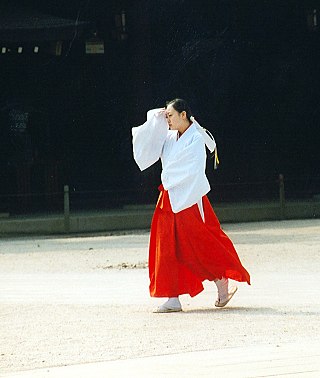
A miko, or shrine maiden, is a young priestess who works at a Shinto shrine. Miko were once likely seen as shamans, but are understood in modern Japanese culture to be an institutionalized role in daily life, trained to perform tasks, ranging from sacred cleansing to performing the sacred Kagura dance.

A Shinto shrine is a structure whose main purpose is to house ("enshrine") one or more kami, the deities of the Shinto religion.

State Shintō was Imperial Japan's ideological use of the Japanese folk religion and traditions of Shinto. The state exercised control of shrine finances and training regimes for priests to strongly encourage Shinto practices that emphasized the Emperor as a divine being.

Chōsen Shrine was the most important Shinto shrine during the Japanese colonial period in Korea. It was built in 1925 in Seoul and destroyed soon after the end of colonial rule in 1945.
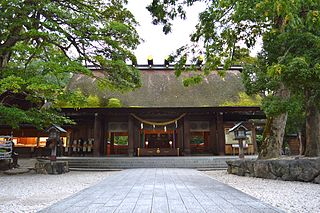
Kono Jinja (籠神社) is a Shinto shrine in the Ōgaki neighborhood of the city of Miyazu in Kyoto Prefecture, Japan. It is the ichinomiya of former Tango Province. The main festival of the shrine is held annually on April 24.The shrine is also called the Moto-Ise Kono Jinja (元伊勢籠神社), and its kannushi has been in the Amabe clan since the Kofun period.
Secular Shrine Theory or Jinja hishūkyōron (神社非宗教論) was a religious policy and political theory that arose in Japan during the 19th and early 20th centuries due to the separation of church and state of the Meiji Government. It was the idea that Shinto Shrines were secular in their nature rather than religious, and that Shinto was not a religion, but rather a secular set of Japanese national traditions. This was linked to State Shinto and the idea that the state controlling and enforcing Shinto was not a violation of freedom of religion. It was subject to immense debate over this time and ultimately declined and disappeared during the Shōwa era.
Shinto is a religion native to Japan with a centuries'-long history tied to various influences in origin.
Sect Shinto refers to several independent organized Shinto groups that were excluded by law in 1882 from government-run State Shinto. These independent groups have more developed belief systems than mainstream Shrine Shinto, which focuses more on rituals. Many such groups are organized into the Kyōha Shintō Rengōkai. Before World War II, Sect Shinto consisted of 13 denominations, which were referred to as the 13 Shinto schools. Since then, there have been additions and withdrawals of membership.

Ichinomiya Jinja (一宮神社) is a Shinto shrine in the Ichinomiya neighborhood of the city of Tokushima in Tokushima Prefecture, Japan. It is one of the shrines claiming the title of ichinomiya of former Awa Province. The main festival of the shrine is held annually on October 18.
Fuyo Jingū was a planned Shintō shrine in Buyeo. It was intended to help with the Japanese occupation of Korea and to be ranked as a Kanpei-taisha. Construction started in 1939 but was never completed. It was highly significant in propaganda with many describing it as the second Shintō capital after Ise Grand Shrine.
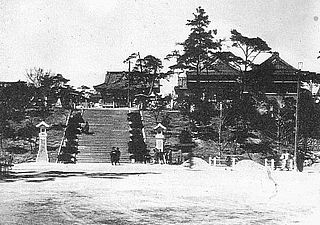
Ryūtōsan Shrine (龍頭山神社) was a Shinto shrine in Korea. It is the earliest shinto shrine in Korea built by workers of the local Japan House trade office in 1678. Such shinto may have served a purpose of expressing and maintaining a Japanese identity outside of Japan, while the Japanese and Korean people lived relatively close during this period.
Kunitama (国魂) is a type of kami or god who acts as a tutelary deity or guardian of a province of Japan or sometimes other areas in shinto.

Shinmei shrines are shrines dedicated to the worship of the Japanese solar deity Amaterasu. The head Shinmei shrine is Ise Grand Shrine which inspired the Shinmei-zukuri architectural style.
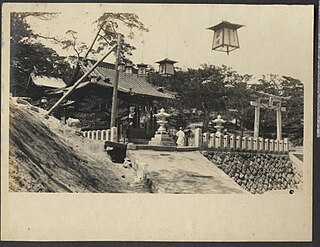
Keijō Shrine, sometimes Seoul Shrine, was a Shinto shrine in Keijō (Seoul), Korea, Empire of Japan. The shrine was established on November 3, 1898, and destroyed on November 17, 1945, several months after the end of colonial rule.















